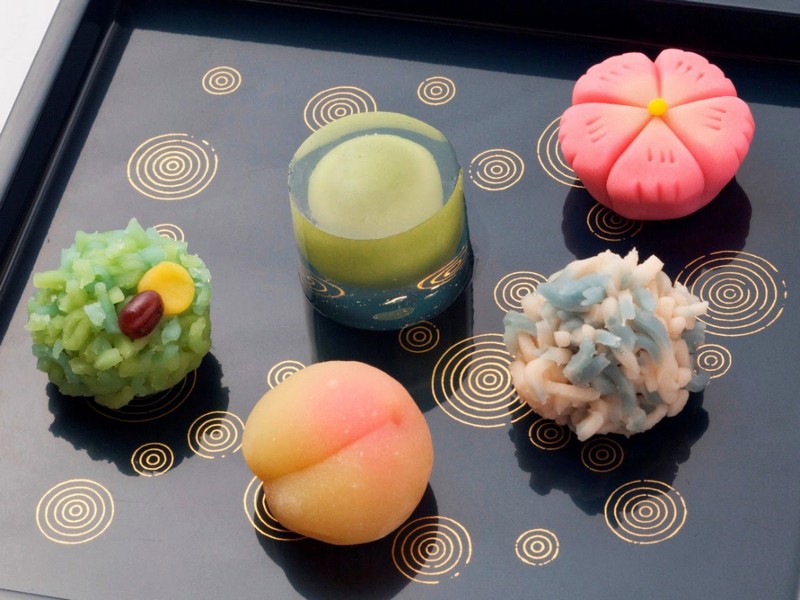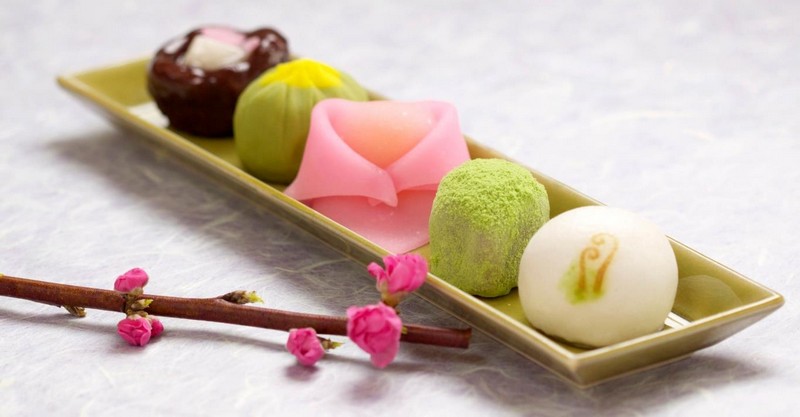(#wanderlusttips #wagashi) Wagashi is not simply a dish. It has become a sophisticated art form that celebrates the natural beauty of the four seasons. Starting with fresh, natural ingredients, Wagashi chefs pour their emotions and creativity into each dish, creating delicate flowers that make the Japanese culinary paradise come to full bloom
[rpi]The four seasons of Wagashi
Discovering the art of creating Wagashi means getting to know one of the beauties of Japan’s culinary culture. At its heart is the culinary quintessence that generations of Japanese cooks have developed and preserved.
Wagashi continuous to morph shape and change colour. From budding cherry petals, to mountains covered with red leaves, a small butterfly, a lovely robin, to tranquil, snowy forests. The delicately decorated Wagashi pieces package both earth and sky inside their tiny bodies, leaving diners in awe and giving them a visual satisfaction that no other dish can provide.

One unique feature of Wagashi are the ingredients. Each season has its own Wagashi, inspired by the changing colours and features of time. Wagashi satisfies different senses and stimulates diners’ imagination and appetite. Wagashi is served with tea, and the dishes are delicate and refined recreations of flowers, plants and animals. Nature’s four seasons give the culinary artisans endless inspiration. In spring, Wagashi come in the shape of blooming flowers; in summer they sparkle like water droplets; in autumn, Wagashi resemble red maple leaves covering the forests and in winter it is grilled golden fishes that warm up a family’s kitchen.
Each Wagashi is like a delicate landscape painting and the brush strokes painted with the kitchen utensils of a skilled chef.
Rice flour (from white rice, glutinous rice, or brown rice), azuki (red bean) puree, ground roasted soybeans, matcha green tea and wasanbon sugar are the main ingredients for Wagashi. Each is a miniature world, leaving diners in awe because thanks to their eye-catching and delicate design, a harmony of colour and taste.
Wagashi stimulates all five senses
Enjoying Wagashi is not merely eating a cake. Wagashi asks of diners to use all of their senses to fully absorb the sophistication.

Sight
For the Japanese, this is a very important factor, as the first thing they take in is the cakes’ presentation. Each one is a beautiful painting, portraying the colourful splendour of life. Wagashi’s shapes, colours and designs are inspired by poetry, art or designs, and resembles nature, birds and flowers.
Taste
The Japanese highly value natural flavours in their culinary culture,. Wagashi is made mainly from a variety of beans and grains, which are traditional and nutritious ingredients. This allows diners to absorb the essence of nature.
Smell
Wagashi has a light and delicate scent, which stems from the baking ingredients. The faint, sweet scent of Wagashi highlights the flavours of the cake, while enhancing the taste of the accompanying beverage.
Touch
The Wagashi is soft and moist to touch but has a crisp feel when you take a bite. This perfect symbiosis comes from the fresh and unique ingredients.
Hearing
Wagashi’s charm originates from their lyrical names. Many of the names come from classical poetry and literature; others are derived from a certain season of the year. The names of Wagashi are elegant and pleasing to the ear. They are most often the names of beautiful flowers, pure and natural sceneries, or drawn from Japanese poetry.
Appealing to all five senses, Wagashi diners will find all the flavours of life hidden within the experience of eating this dish.
Hotel Nikko Hanoi’s Deputy Head Chef has provided Wanderlust Tips readers with the four typical types of Wagashi, representing all four seasons of Japan.

1. Monaka (daisy cake)
Daisies are often associated with autumn. Monaka consists of two crispy round pieces made from glutinous rice flour. In between the pieces is a red bean paste filling. This is a famous specialty that everyone should try in Japan.
2. Ajisai (hydrangeas cake)
This is a light purple jelly cake made from ground pueraria montana (Kuzuko) roots, and cut into circles to resemble hydrangeas (Ajisai). The cakes are usually placed on fresh green leaves before being served to guests. The decoration exudes the taste and colours of the rainy season in June.
3. Nerikiri (five-petal flower)
Kneading ground white beans and Mijinko rice flower together, and then pressing the mix into wooden moulds or handmade shapes make Nirikiri. The cake has a variety of styles, and the shapes depend on the season. However, Nirikiri is most representative of spring.
4. Kantsubaki (Japanese camellia cake)
Kantsubaki resembles the Japanese camellia flowers (Tsubaki) on a cold winter day. The cake has a rich red bean filling, wrapped in a layer of smooth Nerikiriko white bean powder. The cake is dyed pink and shaped like a flower, with a bit of yellow to resemble pistils.
Trang Nguyen | Wanderlust Tips | Cinet